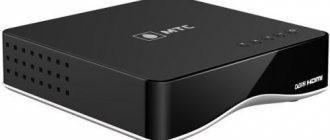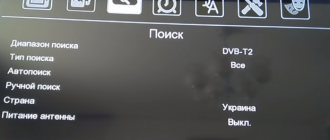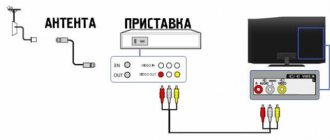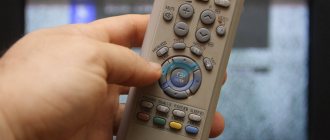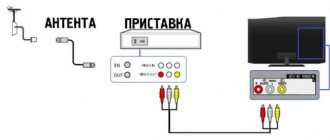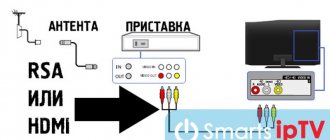What to do if digital channels on your TV are missing, methods for restoring 10 and 20 channels, and features of manual and automatic search for digital television channels. Before trying to solve a problem on the side of the TV, set-top box or check the antenna, you need to check the dates of scheduled or unscheduled maintenance on TV in your region. Perhaps the TV channels are not working precisely because of... Channels have disappeared on the TV - what to do and how to fix it Read more »
Common problems in digital signal reception
Why do digital channels disappear on TVs from LG, SONY and other brands? There are a couple of situations that act as a catalyst for problems in the process of signal reception. Some of them can be solved independently, others require the hands of a professional, so you have to turn to a specialist:
- The set-top box does not support the DVB-T2 digital broadcasting standard. Please be careful when selecting equipment as other countries may have different standards.
- Preventative work is being carried out, which is the reason for the lack of signal.
- The antenna settings have gone wrong, making searching for a signal a little difficult; half the channels are not broadcast.
- The set-top box does not turn on. The motherboard may have burned out. The reason for this could be a sudden voltage surge.
- "No Signal" screen. This is a common sign of problems with the antenna. When the antenna does not work as it should, problems with signal reception immediately begin. When a device has just been purchased and installed, there is a possibility that the programs are not fully configured. It may also be that all channels have disappeared; to solve the problem, look to see if the antenna has moved, perhaps there was a strong wind or bad weather.
- It happens that there are some problems with the connection between the cable and the antenna itself, as well as between the cable and the receiver. In this case, you will need to check how the cable is connected, whether it is plugged into the LNB IN socket.
When you have completed all the actions from the list above, but the signal has not arrived, then it is better to contact the specialist.
Also, do not forget about the connection between digital reception and weather conditions. Each subscriber can notice that when the weather is bad outside, the quality of the image, and therefore the signal, drops. When there is rain, wind or heavy snow outside the window, etc., you can observe a negative impact on the antenna, due to which signal reception deteriorates and the TV does not broadcast channels.
Only after the weather has returned to normal do all processes begin to return to normal operation. So at such a moment you should not try to fix the breakdown yourself, thereby adjusting the channels. After bad weather, make sure that the cable is intact and does not move away from the antenna and set-top box.
The next, no less common problem, due to which the signal reception deteriorates, or there is no signal at all, is the failure of the receiver. There is no need to rush into going to your operator’s workshop or service center; you can take action on your own to help solve the problem.
Quite often you need to replace the power supply (adapter), and after that the operation returns to normal. The power supply may burn out, then it is enough to buy a new device and connect it. A more complicated situation is when the picture on the screen freezes after a short period of work. If the image still does not appear, you will have to visit a service workshop.
Reasons for the problem
It happens that suddenly or immediately after turning on the channels on the TV disappear, what are the reasons for this problem? There are several reasons why channels disappeared:
- A software failure has occurred.
- The signal coming from the TV tower is poor for the selected equipment, resulting in no reception to the TV.
These are the most common situations, and if desired, you can solve them on your own. When the TV does not see channels due to low-quality or broken equipment, then you can purchase a new antenna or install an additional signal amplifier, or take the non-working device to a workshop for repair. You should not disassemble the receiver yourself, as this may make the situation worse.
When the broadcast of channels stops due to a glitch in the program, then you need to figure out the menu yourself and make the settings. Next, we will dwell in detail on manual and automatic tuning.
If all else fails
When all the options described above have been considered for which the receiver does not pick up digital channels, and the proposed solutions did not help, the antenna or set-top box is faulty. This can be easily checked by searching for channels after replacement. It is enough to connect the set-top box to another antenna or, conversely, connect another receiver to your antenna, and make sure that the TV is not searching for channels.
A non-working set-top box or antenna must be taken to a service center, where they will tell you why there are no digital channels.
Loading…
The principle of receiving digital TV channels
Despite the fact that digital television has only recently existed, it is gaining increasing popularity as the user receives high quality images and sound. Another advantage is that it is possible to connect additional programs, functions and use interactive TV.
The principle of operation of the technology is simple - the encoded audio and video signal arrives at the TV through antennas via a special stream, and is decrypted on the TV itself, and the user receives a high-quality image.
Digital broadcasting is received in several ways:
- terrestrial - the picture is received through repeater towers;
- satellite – you can watch a large number of channels, but you need a special dish;
- cable - used in apartment buildings, the signal is transmitted through a collective antenna.
The principle of receiving digital TV channels
The operation of digital TV consists of several stages:
- first, the dvb-t2 signal is transmitted by the broadcaster (via a radio tower, from a satellite, via cable);
- it is then picked up by an antenna, which converts it into current;
- the current enters the receiver, where decoding occurs;
- and as a result, TV viewers see the image.
That is, the main difference from analogue broadcasting is the increased availability, quality of broadcasting and the appearance of additional equipment - set-top boxes.
Necessary equipment
To connect digital TV you must have the following equipment:
- Modern TV, at least manufactured in 2000;
- UHF antenna. Preferably with a signal amplifier;
- Set-top box for digital terrestrial television (aka receiver, aka tuner).
Useful: What is a tuner for digital TV, is it different from a receiver, how to choose
Methods for setting up television
General algorithm for setting up TV channels:
- Go to settings using the remote control. Select “Broadcast” or “Channel Search”.
- Enable auto search or auto tuning.
- Wait for the process to complete. And save the changes.
This sequence applies to all TVs, regardless of the model. Even on older TVs that support digital broadcasting, this setup of terrestrial channels is suitable.
But problems may arise in the process. And after the settings, the error, there are no digital channels on TV, will persist. In such a situation, alternative troubleshooting methods can be used.
TV repairs are 30% cheaper
than in service centers near your home
Order repairs
What to do if auto-tuning does not work
When connecting television without a set-top box via an antenna cable, you need to check its integrity. Then, you can go to the menu and select not the cable, but the “Other operators” option. Carry out a new setup.
If a digital set-top box malfunctions and has stopped showing channels, you must take the following steps:
- Restart the equipment - turn it off and count to 10, then turn it back on.
- Go to the console menu. Find the item "Factory settings". Select them and confirm the reset. If necessary, enter the password 0000, 1111, 1234.
- After restarting, go to settings. Select “channel search” and turn on auto search.
Important! Setting up the set-top box is carried out using the remote control from it, and not from the TV. A factory reset is needed if a complete restart and re-search for channels does not help. If the last point does not work, you need to call a technician to diagnose the equipment.
When the TV powered by a satellite dish stops showing, you must also restart all the equipment by disconnecting it from the network. Then, you can try changing the connection cable. And go to the “Signal Quality” section, select “Strength” and adjust the reception intensity.
Connecting the set-top box to the TV
Before connecting equipment, you must turn it off from the network. Usually, the set-top box itself already comes with a standard RCA-tulip cable, but if it is possible to connect via an HDMI cable, use it for better signal transmission.
Also, some TVs only have a SCART output. In this case, use a SCART-RCA adapter and your problem will be solved.
Let's move on to connecting devices; to do this, follow several steps below.
- We connect the antenna cable to the set-top box, since it now serves as a tuner.
- We connect the set-top box to the TV using an RCA or HDMI cable.
- We turn on the devices.
- On the TV you need to select a video channel, mostly called AV. You can select the broadcast mode by clicking on the source or input button.
Why do channels get lost?
Channels can get lost for various reasons:
- Problems with full memory. If the storage device is full, it cannot save new settings;
- Broken microcircuit that requires replacement. The microcircuit can burn out from overvoltage or exposure to external factors;
- There is a problem with changing the frequencies of the provider, this problem will affect many users at once. In this case, a specialist comes to the rescue;
- Incorrect settings. Perhaps the TV is in store mode, you need to change it to home mode. All settings are in the menu and can be adjusted using the remote control. The most important thing is to understand exactly how to install the gears; on modern models everything is quite simple;
- Incorrectly downloaded channels that do not correspond to the current tariff plan. The tariff plan contains a certain number of programs; the rest will not be able to work normally and will interfere with the operation of the entire system.
Some models have an automatic update feature. It is not always installed correctly; it is better to disable this function. You can choose a manual setting, so the transmissions are less likely to fail. You can try reinstalling the software. The software version is downloaded to a USB flash drive and then transferred to the TV. If the problem persists, it is better to contact technical service.
Only 10 out of 20 digital channels are shown, how to fix
Watching TV is an opportunity to relax and unwind, see what is happening in the country, enjoy your favorite series or TV show. What should I do if 10 out of 20 channels are missing? Is it possible to solve this problem on your own? Can. Over the past couple of years, the number of complaints from digital subscribers has increased just after the channels were updated on the set-top box and certain positions from multiplexes 1 and 2 disappeared. Therefore, the question of why 10 channels disappeared, and what to do if they previously functioned, is relevant.
Most likely, the reason for this situation is the difficulty of signal reception associated with technical work or the characteristic features of the “digital” operation. Since only from the beginning of this year a complete transition to digital has been carried out, there is a possibility that the signal is not received as well as needed. Moreover, RTRS notes that at the moment the work has not yet been stabilized, so there are difficulties in certain regions of the country. So the question of why the channels disappeared will be considered relevant for a long time until the signal supply is finally stabilized in different parts of the country.
What to do in such a situation? In order to find missing channels on digital television, you need to search for channels again or reflash the receiver.
How to choose a set-top box for watching digital TV
At the moment there are a huge number of set-top boxes for digital television on the market. Any DVB-T2 format set-top box is suitable for watching digital TV channels. The cost of set-top boxes depends on many factors, the manufacturer’s brand, additional functions, the number of installed video outputs, etc. Now there are set-top boxes with Smart TV technology on the market.
Main selection criteria
- Supports DVB-T2 and MPEG-4.
- The remote control, in some budget models, the dimensions of such remote controls are mini and control of the set-top box becomes inconvenient.
- The presence of buttons on the front panel of the receiver. These buttons may be needed if the remote control is faulty.
- USB port may be useful for software updates. Also, viewing videos and photos on the console itself is very convenient.
- The TimeShift function is very useful because you can pause it while watching.
- The presence of HDMI video output, but only if this input is on the TV.
- Wi-Fi, this function allows you to access the network.
- Brand and price, when buying a budget set-top box, no one will give you a guarantee of the quality of the product and broadcasting.
- The power supply often fails and having an external one can be replaced in case of failure.
Reasons for the problem
If channels disappear, there are two main reasons to investigate.
Why doesn't the TV find them:
- software failure;
- poor receiving signal of the installed equipment. The TV does not receive a signal.
There are other reasons, but the main ones you should pay attention to are only these two. The problem can be solved on your own if you carry out the appropriate manipulations. If the TV does not find channels due to the equipment, then there are several ways to fix the problem - buy a new antenna or signal amplifier, or send the old equipment for repair. You should disassemble the receiver manually only if you have experience with such manipulations. If the broadcasts stop running due to a program failure, then it is worth making adjustments through the menu.
Antenna HQClear TV: Will we find out a divorce or not? Real reviews
antenna HQClear TV: Will we find out a divorce or not? Real reviews
External reasons
External reasons for the lack of a signal include weather phenomena. Bad weather in the form of heavy rain, snow, wind greatly affects the transmission and reception of the signal.
For example, strong winds can cause an outdoor antenna to spin. In this case, a “no signal” message may appear on the screen. For digital TV, it is very important to correctly position the antenna, find the exact direction or exact angle of inclination of the “dish”.
Moreover, experts recommend using a compass to determine the direction or a special application on your smartphone.
Do not place the antenna near tall trees. They are interference and affect the passage of the digital signal. In addition, in bad weather, branches can break it.
If the message “no signal” appears on the screen after rain or snow, then most likely the reason is bad weather.
Snow can freeze on the antenna, interfering with the signal. To fix the problem, you need to clear it of ice.
- External reasons include the presence of high-rise buildings and other structures in the signal path. Just move the antenna to a different location. But not far from the TV. The further away the antenna is, the worse the quality of the incoming digital signal.
- External causes include a refrigerator or computer operating nearby. They create interference on the network, which can affect image quality. It crumbles into small squares.
Where to point the antenna
Initially, the antenna can be pointed approximately towards the nearest transmitter.
In the Kyiv and Kirovograd regions, transmitters for broadcasting digital TV signals have the following addresses: (The addresses of other transmitters in Ukraine can be found at the end of the article. There is a big sign there...)
Kyiv region:
- Berezan - st. Lenina, 37. Transmitter range (further in parentheses next to the address) 35 km
- Belaya Tserkov - st. Tarashchanskaya, 196 (30 km)
- Dybintsy - Boguslavsky district (40 km)
- Kagarlyk - tower RRS CTE URRT (35 km)
- Kyiv - st. Dorogozhitskaya, 10 (110 km)
- Volodarka - st. Mira, 221a (40 km)
Kirovograd region:
- Kirovograd - st. Sadovaya, 88 (65 km)
- Novoarkhangelsk - Slavy St., 153 (40 km)
- Novomirgorod - st. Lenina, 2 (25 km)
- Novoukrainka - st. Metelkova, 53 (35 km)
- Alexandria - st. Pakhomenka, 2 (45 km)
- Ustinovka - st. Pushkina, 43 (35 km)
Having approximately directed the antenna in the direction of the world where the transmitter should be located, you can begin tuning the tuner itself.
Then it will be possible to install the antenna more accurately and finally secure it, focusing on the signal scale that is in each tuner.
Setting up broadcast channels
Terrestrial TV channels are less likely to go astray than satellite or cable ones. This is due to the stability of the translators. However, even with such a connection, it often happens that the TV unexpectedly does not find channels. In this case you need:
- Check the quality of the cable and TV connection. Try removing the antenna plug and installing it again.
- Visually inspect the wires around the apartment or house. Make sure there are no bends, creases and no furniture on it.
- Check with your neighbors to see if their TV is on. There are problems on the line.
- Buy a signal amplifier if your house is located far from the repeater. Amplifiers improve connection quality and failures are rare.
Advice. If over-the-air channels are received through the antenna, try rotating it or placing the amplifier directly on it. Also make sure that there are no metal objects near the receiver (“dish”). They greatly reduce the quality of reception.
Setting up digital channels
Let's imagine that the channels on an LG TV are missing, how to set them up? Remember that, regardless of the manufacturer, there are only two options for getting out of this situation.
Channels disappeared on LG TV, how to configure them? Use YouTube. Quite often, users of different TV models post video instructions on their own.
Every user can set up missing channels on a Samsung TV and more. This process takes about 10 minutes. You can use automatic search or manually configure all channels yourself. The first option is considered more popular, since it minimizes subscriber intervention. In general, often after turning off analogue channels, digital ones disappear and need to be adjusted.
Automatic search
Let's look at the most popular method right away. So, you will need a remote control and the TV itself. When all digital channels have disappeared, auto-tuning requires the following manipulations:
- On the remote control we need to find a button that will take us to the “Menu”. Please note that this button may change its location on the remote control depending on the manufacturer. To simplify your search, you can use the instructions for the remote control.
- Then go to the “Settings” section, then to “Automatic settings” and select them.
- The search begins, it is important to wait until the search is completed, and do not turn off the TV at this time.
If the search is completed without interruption and the signal is normal, the subscriber should receive a minimum of 20 channels. There are situations when, after such a process, almost all TV channels may disappear, or half of the list that was there before the update may remain. Accordingly, in such a situation, an alternative solution is manual configuration.
Manual search
Please note that before you begin manually searching for channels, you will need to find out information such as:
- The broadcast frequency of channels that are interesting to you, or they were not found during the auto-tuning process.
- The speed of the channel, each one that interests you.
Having received such data, you can begin the setup procedure, here you will also need to use the remote control:
- Go to “Menu”.
- We are looking for “Manual setting”.
- Then you will need to enter in the fields all the data that you previously learned from the provider. Be sure to save them.
- Activate search.
This process will need to be completed for each channel that you want to find. It happens that it is necessary to make changes to the digital series to improve image quality. This process will take longer than auto-tuning, but you will be able to configure the channel as efficiently as possible.
When the problem persists and the TV still does not find and tune in free digital channels, there is a possibility that the cause of the problem is that the signal format does not meet the set-top box standards. It also happens that channels simply go out of television range, in other words, they close down. In this case, no settings or actions will help.
If one or more channels are missing
You may encounter a situation where the receiver finds almost all channels, or only one is missing.
This case is considered separately, because there are several reasons for this:
- Technical work on the provider's side. This is always reported on the official website. One operator can serve several television programs at once, and it is possible that channels disappeared from the air for this reason.
- Stop broadcasting. If there is no specific channel, he has turned off digital broadcasting or changed the operating frequency. Detailed information about this can be found on the channel's website.
And the last option is when the set-top box finds only half - 10 channels.
This means that in the area of residence there is no broadcast of the second package, and the channels of the first multiplex (RTRS-1) are working.
Advice! It is not recommended to immediately look for a problem in the settings; it is better to contact the provider or get information about the performance of the channel and reception settings on the TV show website.
Reasons for the lack of signal through the set-top box
Digital set-top boxes are designed to decode digital signals and transmit them to a TV. They may become outdated. Then you just need to buy new equipment. Failure - checked by restarting and resetting to factory settings.
Often, after a thunderstorm or a strong power surge, the receiver fails. Recovery after a short circuit is almost impossible. You'll have to buy new equipment.
Important! Cable or satellite TV may be unavailable due to insufficient funds to pay for the package or due to technical work on the part of the operator. In the first case with payment, 20 on-air channels should work. In the second, you need to call the operator and clarify the situation.
Firmware update on Smart TV
If you have a TV with Smart technology, then it needs an update to work correctly.
Smart TV is a TV combined with a computer. And the firmware is its operating system. Therefore, for the TV to work well, it must be updated periodically.
How to do it?
Update algorithm:
- — Connect Smart TV to the Internet. This can be done via a personal computer or via Wi-Fi.
- — Using the remote control, enter the menu and select the “Update Software” tab.
- — The update will start automatically after your confirmation.
- — Once the update is complete, the TV will reboot.
- — After turning it on, you may need to configure the channels.
Preventative work
Several times a year there is such an unexpected situation when you turn on a previously working TV and tuner, but “it doesn’t show.” And not only from you, but also from your friends and neighbors who use the window to the world using T-2 technology.
It is quite possible that now “scheduled maintenance work is simply being carried out on the equipment of the multiplexes MX1, MX2, MX3, MX5 of ZEONBUD LLC.”
That is, in human terms, the provider has turned off all the equipment that creates the picture on your TV and checks something there. This procedure usually takes half a day, and the shutdown schedule can be viewed on a special page .
In 2021, for example, it is May 24 and September 6 from 5 a.m. to 2 p.m.
If your TV supports digital TV
Then you don't need to panic. In fact, almost all modern LCD and LED TVs that have been on sale since 2015 support the DVB-T2 standard. Even this 15-inch Harper , the cheapest on the entire Yandex.Market, has a built-in tuner that “catch” digital TV:
- If you are connected to a community antenna in your home , that's where your adventure ends. House antennas on roofs usually have enough power to receive a digital signal, and your TV will pick it up on its own. Just start auto-searching for channels when digital TV reaches your city.
- The same thing if you have an individual decimeter antenna . For example, outdoor “Thunderstorm” or “Albatross”, or indoor “VVK” or “Delta”. Any Chinese “horns” for 150 rubles, which can receive decimeter waves (UHF) or all types of waves, will catch your “digital”.
( 1 rating, average 5 out of 5 )
When the diplexer is connected
If both digital and satellite antennas are connected to the set-top box, you need to understand that they remain different devices. On the user side they work as a single device. But everyone has their own working conditions:
- Signal reception. The quality of the incoming signal and climatic conditions are important for the antenna, regardless of location, because... the ground station covers the entire area around the house. On the contrary, a satellite dish receives a very powerful signal with a frequency above 10 GHz and is received in any weather, but there should be no large obstacles (buildings) between the satellite and the dish.
- Broadcasting. Satellite and digital are different types of broadcasting. If there is a temporary shutdown or change of frequency on one channel, the broadcast continues on another.
If, when using diplex, the broadcast is carried out only on one of the signals (DVB or DVB-T2). Problems are observed exclusively with one of the receivers. When one channel is missing on both signals, repair work is underway.
Important! When using a diplexer, you first need to find out which device is incorrectly searching for channels. To do this, you need to connect each receiver separately and see the result.

